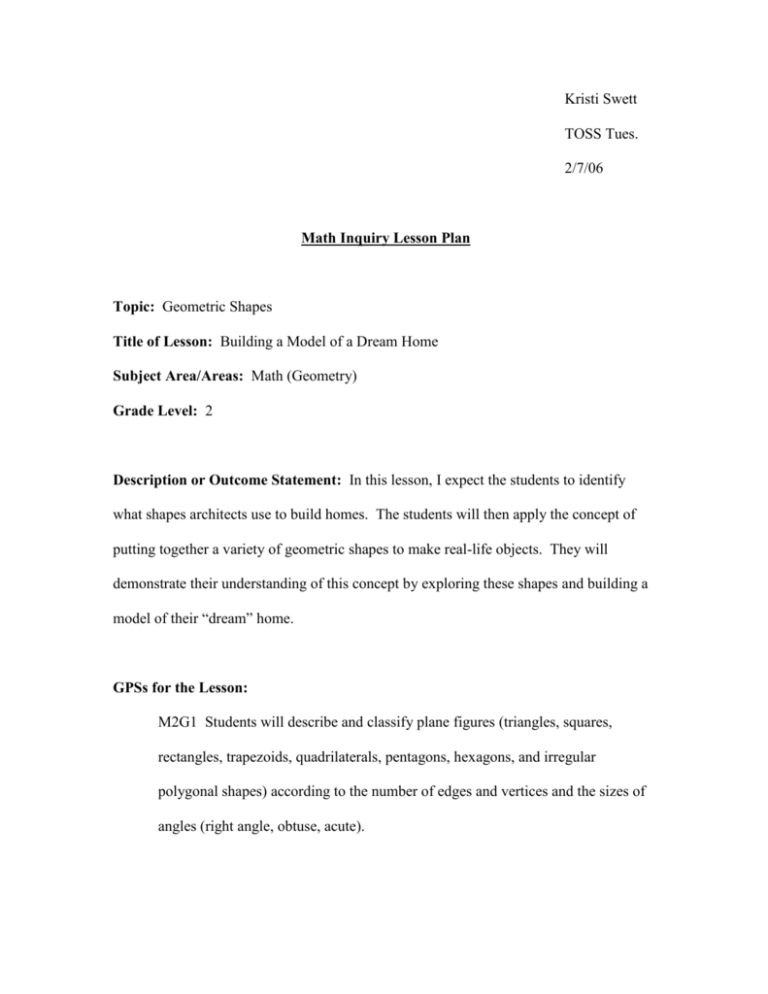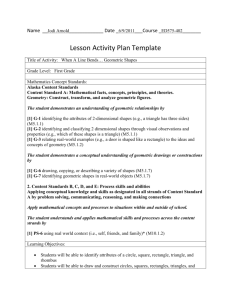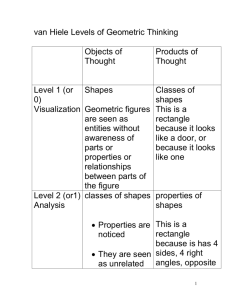grade2-geometry
advertisement

Kristi Swett TOSS Tues. 2/7/06 Math Inquiry Lesson Plan Topic: Geometric Shapes Title of Lesson: Building a Model of a Dream Home Subject Area/Areas: Math (Geometry) Grade Level: 2 Description or Outcome Statement: In this lesson, I expect the students to identify what shapes architects use to build homes. The students will then apply the concept of putting together a variety of geometric shapes to make real-life objects. They will demonstrate their understanding of this concept by exploring these shapes and building a model of their “dream” home. GPSs for the Lesson: M2G1 Students will describe and classify plane figures (triangles, squares, rectangles, trapezoids, quadrilaterals, pentagons, hexagons, and irregular polygonal shapes) according to the number of edges and vertices and the sizes of angles (right angle, obtuse, acute). M2G2 Students will describe and classify solid geometric figures (prisms, cylinders, cones, and spheres) according to such things as the number of edges and vertices and the number and shape of faces and angles. a. Recognize the (plane) shapes of the faces of a geometric solid and count the number of faces of each type. b. Recognize the shape of an angle as a right angle, an obtuse angle, or an acute angle. Specific Lesson Behavioral Objectives: 1. After a class discussion about geometric shapes and how they are used in architecture, the students will correctly identify and label on a worksheet at least 11 of the 13 geometric shapes (including cubes). (cognitive) 2. The students will work cooperatively in groups to create and execute a plan to build a model of a home using at least two plane figures and three solid figures using patterns on construction paper. (affective, psychomotor) 3. The students will create geometric solid figures (cone, cube, rectangular prism, and cylinder) using patterns on construction paper with 100% accuracy. (psychomotor) Materials Needed: one geometric shapes worksheet for each group of 2 - 4 students, patterns for solid figures, patterns for plane figures, construction paper, two pieces of plain white paper per group, tag board, scissors, glue, pencils with erasers, architectural magazines or pictures of homes for viewing and reference, timer or clock with second hand, prepared materials: a set of photocopied shape patterns onto construction paper (make 2 copies of each shape for each group), then a set of one of each solid figure to each child Procedures: 1. Motivation (Launch): 10 minutes I will start by engaging the students in a class discussion about dream homes. TI: “How many of you would like to live here?” (show them a picture of a mansion from a magazine or picture) SR: “Whoa! I want to live there! Does it have an elevator?” TI: “It probably does have an elevator! I’m not surprised to see that many of you would want to live here – I don’t see why not. Have you ever seen a mansion in real life – one of these really big houses that cost millions of dollars? Have you ever been in one?” SR: “I haven’t been inside one, but I’ve seen them on T.V.!” SR: “Yeah, like on the show CRIBS.” TI: “Oh, me too! Is it your “dream” home?” SR: “Well, I kind of like beach houses.” TI: “Oh, yes, I would love to live in a beach house maybe during the summer when we have summer break! Maybe one that looks like this one.” (hold up a picture of a beach house in a magazine) SR: “Oh, cool! It has a pool!” SR: “I have a friend that lives in a log cabin – I like to spend the night there!” TI: “So, your dream home is a log cabin?” SR: “Yeah, like my friend’s.” TI: “That’s another great dream home. Well, how do you suppose your dream home would be built? And who would build it? Would they just show up to the site and start building or do you think they have a plan first?” SR: “Builders would build it. And they have a picture of a drawing to look at when they’re building it. What’s that called . . . a map?” TI: “Oh, you’re thinking of a blueprint. Okay, good! How many of you know what an architect does? What is the difference between architecture and an architect?” SR: “I want to be an architect one day because they design buildings and they make a lot of money!” TI: “What a great career! What shapes do architects use to build things? Are those three-dimensional or two-dimensional?” SR: “Ummmmmm…” TI: “What do you already know. . .remember back to yesterday when I showed you what each shape looks like – there are plane figures and solid figures.” (students begin naming the figures – make sure that each shape is mentioned in the discussion) TI: “Wow, great job! Well, how would you like to build a dream home?” SR: “Awesome! Are we building something today?” TI: “Yep, you’re going to join a team of other architects. Together, you will design a model of your dream home. Here is an example of a dream home that some students built in my class last year. They used all kinds of shapes and they were creative – they even built a driveway and a sidewalk for it. I will leave it on this table for you to look at, okay? But, first I want to see if you’ve been listening. . .” 2. Investigation – Lesson Development: (100 - 140 minutes – spread out over two days if needed) Motivation: ~ Begin the lesson with a class discussion similar to the discussion mentioned above. Talk about dream homes, architecture, and geometric shapes. (10 minutes) ~ Facilitate a motivation exercise with cooperative groups of 2 – 4. (10 – 15 minutes) TI: “I’m going to put you in groups according to the type of dream house you would like to have – you will stay with this group of “architects” and build this home together. When you get in your groups I want you to sit down with your group at one of the groups of desks (already set up) – there should be one pencil at each group. Alright, your choices are beach house, log cabin, mountain home, city high-rise apartment, or a lake house. Okay, if you want a beach house, raise your hand. Y’all go sit down. Now, if you want a log cabin. . .” (keep going until all groups have been formed). Teacher will then pass out one geometric shapes worksheet and a couple sheets of plain white paper to each group and then tell the class they have two minutes to identify and label the geometric shapes on the worksheet. (Tell them the plain white paper will be used later.) The team to get the most correct answers will get ten minutes of free time. The catch is that each student will label only one shape and then pass the paper to the next student – there is no talking. Tell them you will announce the twenty-second warning and at that time they can openly discuss and label any shapes they have missed or were labeled wrong. Planning the Homes: ~ Explain to the students that they will be using at least two of the plane figures and at least three solid figures from the worksheet to build their homes. (5 minutes) ~ Distribute to each child (still in their groups): one of each solid figure pattern on construction paper, scissors, and glue. Have the children follow along as you demonstrate how to make cones, rectangular prisms, cylinders, and cubes from the photocopied patterns using the glue and scissors. They will need to know how to make these in order to use them for their homes – they can contribute these shapes to the materials needed in their group to build the homes. (20 minutes) ~ Discuss with the class that they will be acting as architects and that it is very important for architects to have a plan. Give the students enough time to plan and draw their home on a piece of plain white paper (one extra if needed). Tell them they may get one of the architecture magazines/pictures to look at for ideas. Walk around and make sure that each group is on track. (15 - 20 minutes) **At this point, the teacher can stop the activities for the day and continue from here on the next day of class.** Building the Homes: ~ As each group finishes, they may send two members of their team to the materials table where all the materials will be set up (photocopied patterns, glue, scissors, and tag board). ~ The groups will build their homes using the tag board as the base. Encourage the class to do their best when building their structure. Creativity is a positive thing. So, if the students decide to make something else instead of what you asked, be flexible (as long as they are using a variety of shapes and as long as they can justify their real life structure). (30 minutes) TI: “Wow, I’m observing your groups and looking at your dream homes and I know that I would love to live in them! Are you working well with your groups? Do you have any questions or need help?” SR: “Well, we noticed that our house looks more like a boat! Can we make a boat house?” TI: “Absolutely! That’s a great idea! You could certainly have a dream home on water, huh?” SR: “Yes, like a yacht or a cruise ship! We could live anywhere in the world because we could get there by our boat!” SR: “Can we draw on the house?” TI: “Great question. What would you like to draw?” SR: “We were thinking about windows and doors.” TI: “You could do an endless number of things to your home! Be creative. Doors and windows would be great. Don’t forget that you have scissors as well. . .as long as you don’t cut the shape and accidentally make it another kind of shape. Plan carefully just like architects have to – make sure that you have a stable base for example.” SR: “We want to make our own shape.” TI: “Wow, what kind of shape do you need?” SR: “A roof.” TI: “Okay, well, you could use a pyramid for a roof. Do you need a pattern for a pyramid or do you already have something planned for that?” SR: “Well, the base of a pyramid is a square and the sides come up to a point. But we’re not sure how to make one.” TI: “I can certainly make a pattern for you to cut out real quick. I’ll show you how to fold it and adhere it, okay?” SR: “Okay. Thanks!” TI: “Do any of the other groups want me to make them a pattern for a pyramid to use for a roof?” Presentations: ~ Display their creations for all to enjoy. Have each group present their creations and explain how they planned it and how they built it. Have them point to and name each of the shapes in order to assess them. (20 minutes) 3. Closure – Summarize: (5-10 minutes) I will have the students go back to their regular seats after the presentations are over. I will ask them questions and have them respond. TI: “What did you learn from this activity?” SR: “That it isn’t easy building homes and you need to make sure that you have everything you need before you begin to build!” TI: “Absolutely – that’s why I always tell you to be prepared for class right? So that you’ll be ready to do whatever it is that we’re doing that day. That is a great lesson to be learned! It takes a lot of planning to build homes, buildings, schools, boats, etc. What did you like best about the activity?” SR: “I liked building the homes. But the shapes kept coming undone.” TI: “Well, I’m glad that you enjoyed the building aspect. The shapes were giving you some trouble? Hmmmmm…maybe I should plan this better for my class next year. Do you think we should have made the shapes and let the glue dry completely before we use them?” SR: “Yeah, we should have done that.” TI: “Thank you for the suggestion. But I’m actually excited that the shapes kept coming undone because it presented a real life problem. The houses look like they are holding up pretty well now, so I guess you solved the problem and fixed the shapes. Do you suppose that architects have the same kind of problems?” SR: “Oh, yeah! The wood they use may break or their tools may break!” TI: “Exactly. Sometimes architects run into problems, but they have to know how to solve the problem. So, who can tell me what subject we studied today and what three-dimensional shapes (or solid shapes) are?” SR: “Math. Oh, Geometry! And solid shapes are cylinders, prisms, cones, and. . .” SR: “Cubes!” TI: “Great! And what do architects do?” SR: “They create, plan, and help build things! And they make a lot of money.” 4. Accommodations: ~ To accommodate ESL children, I would teach them the names of the shapes in their language and put them in a group with other children that speak their language – I would assign a buddy to translate for them if needed. I might also do a small, personal demonstration of building something using the shapes. Shape books in their language might help also. ~ For children with physical needs, I would assign them a trustworthy and helpful student to guide them through the processes and let them be a group of two so that the child with physical needs receives more hands on opportunities. I would also make sure they sit close to the materials and that they have a good view of the demonstrations. If it were a hearing need, I would stand close to this child during instruction. Visual learners need to be close to the teacher during demonstration as well. ~ Children with ADD/ADHD will need to do a lot of hands-on activities. So this activity should be one that is enjoyed. I would put this child in a group of students that will understand if I ask them to let this child do the labeling on the motivation game worksheet as the students give him/her the answers. I would stand close to this child as to allow him/her to clearly see the pictures and/or magazines. Also, it might be a good idea to put him/her in a smaller group to allow more hands-on opportunities. 5. Gearing Down: For those students who might find this too challenging, I would let them use building blocks or attribute blocks to build the houses and allow them to use as many shapes as they possibly can. 6. Gearing Up: For those students who need a challenge, I would let them build a neighborhood and write a story about it. 7. Assessment: An assessment that I feel will work best with evaluating the students’ learning is an observational checklist. Observational Checklist for Building a Dream Home Student Name: _______ 1. Student participated in a class discussion about geometric shapes used in architecture. 2. Student correctly identified and labeled certain ________ geometric shapes on the worksheet. ________ 3. Student worked cooperatively in a group to create and execute a plan to build a model of a home using at least two plane figures and three solid figures. ________ 4. The student accurately made each solid figure using the construction paper. Grading Scale: 4 out of 4 checks: accomplished 3 out of 4 checks: in progress less than 3 checks: not evident ________









